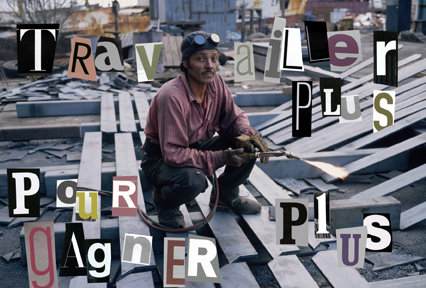Allan Sekula
dal 7/3/2008 al 4/4/2008
Segnalato da
7/3/2008
Allan Sekula
Galerie Michel Rein, Paris
"Shipwreck and Workers" consists of photos from a portable, temporary monument to labor; "Travailler plus pour gagner plus" is taken from a series of happy-captioned ransom note overlays on a photo of a shipyard welder cutting steel in Ensenada, Mexico.

Galerie Michel Rein is happy to present Allan Sekula’s fourth solo
show at the gallery. Sekula’s recent series of photographs,
Shipwreck and Workers, was shown at the last Documenta in Kassel
(curators: Roger Buergel and Ruth Noack, 2007). Retrospective
exhibitions of his works are in preparation in Europe and in the
United States : at the Renaissance Society in Chicago (2008) and at
the Zacheta Gallery in Warsaw (2009).
Notes for exhibition at galerie Michel Rein, 2008.
- Shipwreck and Workers: photos from a “portable, temporary”
monument to labor, last installed outdoor in the Bergpark, below the
Hercules monument in Kassel, for Documenta 12. The shipwreck floated
on a raft in the Neptune Basin. The viewer climber over 500 steps to
see the other photos flanking the stairs. It’s hard work to look at
work. Twelve photos of work and workers to recall the twelve labors
of Hercules, Stakhanovite-madman of the ancient world. By contrast,
who would dare to erect a monument to Medea?
The Museum Guards—one a poet, the other a cartoonist—are working
at the Henry Art Gallery in Seattle, where Fish Story was exhibited
in 1999.
- Travailler plus pour gagner plus: from a series of happy-captioned
ransom note overlays on a photo of a shipyard welder cutting steel in
Ensenada, Mexico (original photo 1996, from Dead Letter Office,
exhibited at galerie Michel Rein in 1998). Alle Menschen werden
Schwestern (All people will be sisters) shown outside Kassel
Wilhelmhoehe Bahnhof during Documenta 12. Second version: Los ricos
destruyen el planeta (The rich destroy the planet). Rare Sekula
foray into direct image-text juxtaposition rather than “relative
autonomy” of the two elements. Slogans for the 21st century.
Graphic design assistance: Ina Steiner.
- Lao Studies: Sekula visited Luang Prabang and the region
surrounding the city in October 2005 and January 2006. During his
visits, he shot footage for a film, titled A Short Film for Laos
(2006), as well as a series of photographs. Two of the diptychs are
B-52 Crater, which depicts a bomb crater in the Plain of Jars, a
region of Laos that is still pockmarked with craters from bombs
dropped during the Vietnam War, and Whisper, which portrays a Lao
village woman whispering to a friend. Describing these photographs,
Sekula has written: «B-52 is the third photograph I have made
comprised of a ‘split-basin,’ that is, a circular depression seen
at an oblique angle so that it appears as an oval or ellipse and is
divided evenly between two frames down the middle. The other two are
Doomed fishing village of Ilsan (1993) from Fish Story and Oil
recovery pit, Lendo (2002) from Black Tide. The divided frame is a
way of ‘domesticating’ a topographic feature, more or less
treating it like a kitchen sink. The residual violence recorded in
B-52 Crater, the thirty odd years that have passed since the ear-
blasting shock of the explosions (one was lucky to lose only one’s
hearing), leads to Whisper, a moment of inaudible private
conversation between two Lao village women. This is one of a number
of photographs I have made in which listening or speaking is central,
such as Dockers listening (1999) from Freeway to China.»
A Short Film for Laos (2006), which was presented at the last
Istanbul Biennial (curator: Hou Hanru, September 2007), will also be
featured in the show.
“Call it an essay on what the world’s made of, i.e. water and fire
and iron and earth. Wryly ironic, compassionate, and
unprepossessingly simple.” Olaf Möller, Film Comment, January 2008.
Vernissage march 8 16h-21h
Galerie Michel Rein
42, rue de Turenne - Paris
Free admission



